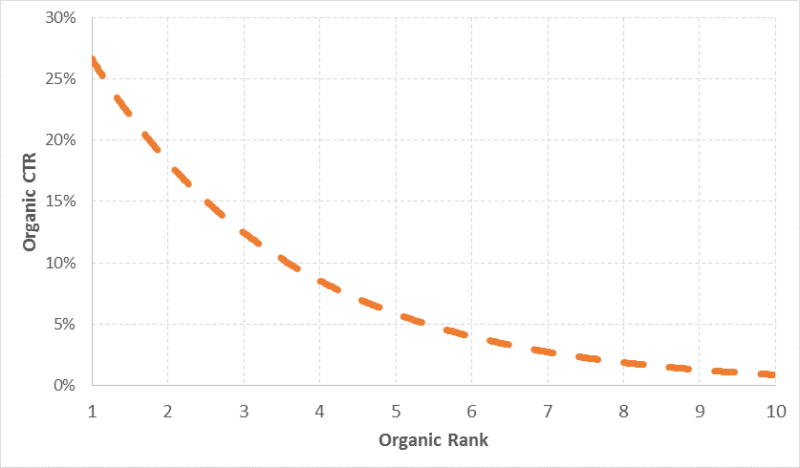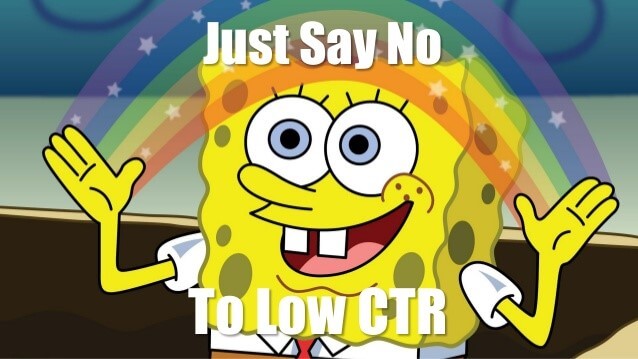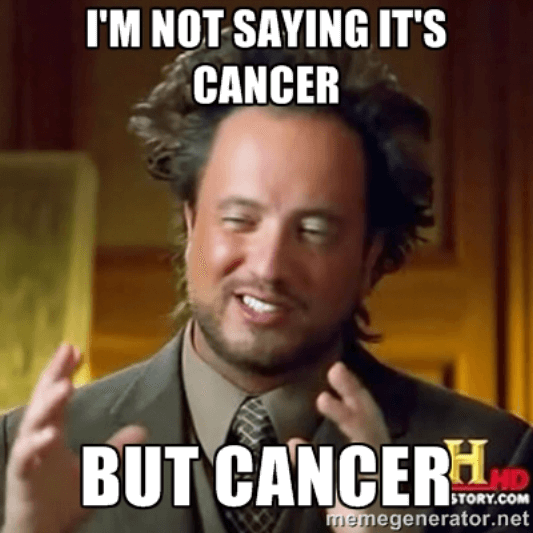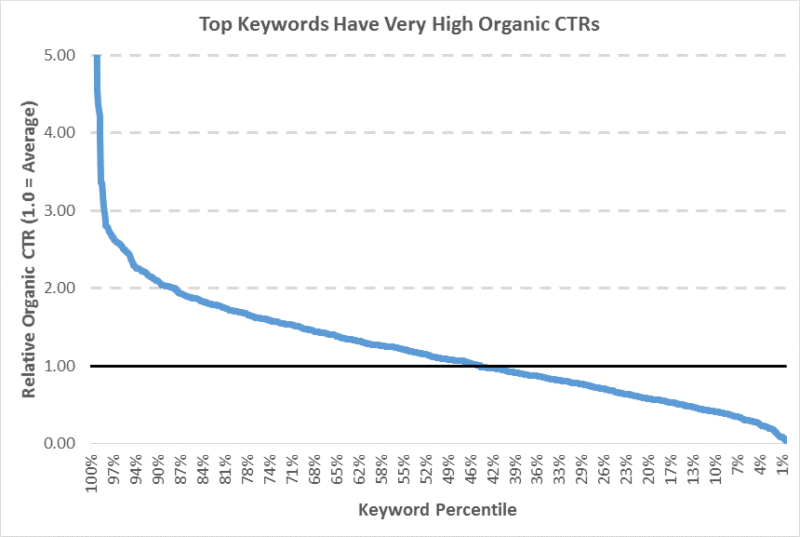5 brilliant headline hacks for crazy high organic click-through rates
Just say no to low CTR! Columnist Larry Kim explains his tactics for improving click-through rates on organic search listings.

What is the most important ranking factor? Ask 1,000 SEOs and you’ll get a wide variety of answers.
Getting links and creating great content would definitely be two of the more popular answers, and for good reason. After all, that’s what Google says are the two most important ranking factors.
But there’s one other factor you can — and should be — focusing on. It’s something that could double your traffic. Yet so many people are overlooking it.
Your organic click-through rate.
Why low CTR is kind of a big deal
You’re losing weight but not exercising. You’re constantly tired and having unexplained aches and pains. All of these symptoms point to something.
Does your website have cancer? Do you have the symptoms?
Are people bouncing off your pages like rubber balls? Is your click-through rate ridiculously low?
If so, it’s dragging down your overall domain-level engagement metrics.
What’s the cure? Is it to build more links to your crappy content? Is it to create more infographics or dream up some PR stunts? All of these may help in the short term, but your site still has a cancer you need to eradicate.
How do you figure out organic CTR & low CTR keywords?
Honestly, this is hard to do. Google doesn’t provide you with a Quality Score number to tell you if your content is above or below the expected click-through rate.
But that doesn’t mean it’s impossible to figure out. In fact, I’ve developed a hack to determine which of your keywords are most likely underperforming compared to the expected click-through rate:
Download all of your query data from Google Search Console and plot CTR vs. Average Position for the queries you rank for organically. Here, I’m using my own website data for wordstream.com:

CTR vs. Average Position for Wordstream.com. Data from Google Search Console.
Next, plot an exponential trend line. The queries that fall below your average CTR are your most at-risk queries.
You don’t need to worry about any queries that score above the trend line. After all, your goal here is to turn your losers into winners, which is far less risky than accidentally turning your winners into losers!
To prioritize your optimization efforts, you can do a secondary sort on your most “at risk” pages using a metric like page views or conversions generated by those keywords.
Click-through rate varies based on the vertical. WordStream.com (which is where my data comes from in this particular example) is in the internet marketing vertical, but I would expect similar results for other internet marketing sites like Moz and Search Engine Land. In any case, here’s what an average CTR looks like for my website:

Average CTR on Wordstream.com, by ranking position in Google. Data from Google Search Console.
However, there is great benefit of being a unicorn in a sea of donkeys.
- The top 1% of my highest CTR keywords beat the average CTR by 6x.
- The top 2% of my highest CTR keywords beat the average CTR by 3x.
- The top 10% of my highest CTR keywords beat the average CTR by 2x.
What does it all mean? There’s a lot of leverage here if you take the time to make your headlines more “clicky.”
Most SEO titles suck
Optimized titles are boring. Everyone is using the same keywords in their titles in the war for shrinking SERP territory in the hopes of attracting the most clicks.
Oh wait, you stuffed two or three high-value keywords in there? Great. But are people actually clicking on it? Is it ranking as well as it could be?
Oh, you’re thinking of adding a comma or an exclamation point? Really! That’s the solution to your low CTR?
When you’re doing SEO, content is a crucial element — both what’s on the page and around the page. Google looks at the context of your whole site (e.g., is it in a particular niche?), not just individual pages. Any given page on your site could rank for hundreds of different keywords. So how does Google know where to rank your page?
CTR is the difference between finding yourself in a virtuous cycle or a death spiral.
In a virtuous cycle, you’re getting more clicks. This sends important user engagement signals to Google that this is a good page/website, which ultimately results in better positions for more of your other pages and more traffic.
In the death spiral, however, you have stupid SEO title tags. You’re barfing the same title over and over and people aren’t clicking. The result: poor rankings and even less traffic.
But there is a cure.
The surprisingly simple cure for crappy titles
You need to write more clickable titles than everybody you want to outrank. Great SEO titles should be like click-bait headlines — just better optimized for your most important keywords.
It’s that simple, yet also that insanely difficult. Or at least, maybe it seems that way.
Many people struggle to write outstanding headlines. If only there were some research on what makes a viral headline.
Good news: There is!
According to Steve Rayson of BuzzSumo, the same emotions make people share or click on an article. Titles that inspire awe, laughter, amusement, anger, joy, empathy, surprise or other emotions are insanely powerful triggers and can transform your biggest losers into winners.
So, based on Rayson’s research — and using the most popular Moz content from the past year as our example — here are five hacks to write headlines that will get crazy high click-through rates.
1. Format
Your content can come in many formats. It might be a list, an ebook, an infographic, research, a quiz or a how-to.
Stating the format in your headline is a great start to encouraging more clicks. Just make sure your headline delivers on its promise to your audience — never do deceitful click bait!
All five of our Moz examples above make clear the type of content that we’ll get after we click. Three of these posts use a number: “3,” “10,” “Single” (aka 1). So when you click through, you’d expect to find a post organized to highlight the 3, 10 or 1 thing(s) promised in the headline.
The other two are Whiteboard Fridays, which is a format Moz regularly uses. But in addition, both of these popular posts have a second format element — one asks a question, while the other is a “how-to.” So if you want to know the answer to the question or want to learn how to do something, this encourages you to click.
2. Emotion/hook
Now you need to hook your reader. Use an emotional element or a superlative — words like “surprising,” “inspiring,” “funny,” “brilliant” and so on.
Surprisingly, again looking at our Moz examples, only two of our five headlines include the emotional element. My headline uses the word “Unusual” to spark curiosity, while Cyrus Shepherd uses the word “Best,” which will attract clicks from those who aspire to become the best.
The other headlines lack this hook (though the question headline gets a pass because questions do inspire curiosity). Sure, they did pretty well without it, but let’s be brutally honest. Had Joe Blow been the author instead of the Wizard of Moz, it probably wouldn’t have done nearly as well.
If you want higher click-throughs — and the ability to compete with the Rand Fishkins or bigger brands/businesses/influencers in your industry — you need any edge you can get. Add some emotion to your headlines and start increasing your CTR!
3. Content type
A great headline tells you what type of content to expect after you click through. It might be images, videos, charts or quotes. There are tons of possibilities here.
In our Moz examples, four of the headlines have this element, as indicated by the words “Hacks,” “Predictions,” “Tip” and “Build.”
As for the question headline, this one is a bit unusual, as it differs from BuzzSumo’s structure for a “viral headline.” I suppose, by default, the question mark indicates the type of content it is: asking (and answering) a question.
4. Promise
Titles that get higher click-through rates promise something. What will someone who clicks on your content get out of it? Will your piece of content inform, inspire, educate or entertain your target audience? If not, why does it exist?
Four of the five Moz headlines we’ve been using as examples have this element. “Up” and “Improved” convey the same idea — improvement — so by clicking through, I will be educated and improve my knowledge or skills. “Right” and “How to” indicate that by clicking through, I will be informed the correct way to do something.
One headline doesn’t clearly indicate a reader benefit. Will the predictions help me in some specific way? Will they help me grow my traffic/conversions/sales? Will these predictions force me to rethink my strategy?
Again, if you aren’t Rand Fishkin, conveying a reader benefit could be the difference between your below-average or okay click-through rates and amazing click-through rates.
5. Topic
Obviously, this is the keyword or keywords you’re targeting with your content.
Topics can be evergreen or newsy/trending. These keywords should be relevant to your brand, business or website — whether you’re writing about coffee, drones or click-through rates.
What are the Moz topics? “Your LinkedIn Game,” “2016 SEO & Web Marketing,” “Web Traffic,” “Google Ranking Factor,” “Traffic Metrics Dashboard.”
Do your keyword research and understand your audience and the topics you want to be found for.
Bonus CTR hack: Use remarketing!
A smart way to encourage more organic clicks is to do remarketing with the Google Display Network and Facebook.
Look, organic search can be a good source of traffic. But if you want it to become a great source of traffic, you need more people to click on your search result.
How do you do that? You need to make sure people are familiar with your brand. Remarketing will help you achieve that.
Using Google and Facebook, you’ll show ads to people who visited your site but left before converting. As they visit various websites, they’ll see your ads. Just as this helps increase your conversion rates, it can also help your organic click-through rates.
People who are familiar with your brand are 2x more likely to click on your ads and convert. I’ve found that targeting people who visit your website using remarketing lists for search ads (RLSA) always produces higher CTRs than generically targeting the same keywords to people who have never heard of your brand.
Is remarketing free? No. But neither is SEO. It requires huge investments of time and effort.
Remarketing is proven to:
- deliver more repeat visitors;
- increase brand recall (branded searches, direct traffic);
- improve brand engagement (more page views per visit, longer time on site, lower bounce rate); and
- increase conversions, leads and sales.
Conclusion
Improving your organic click-through rate has many benefits. It will mean more traffic, which will lead to better engagement signals, better rankings and more leads, conversions and sales.
So start figuring out which pages are your biggest losers and get optimizing. Just say no to low CTR!
Contributing authors are invited to create content for Search Engine Land and are chosen for their expertise and contribution to the search community. Our contributors work under the oversight of the editorial staff and contributions are checked for quality and relevance to our readers. The opinions they express are their own.
Related stories
New on Search Engine Land



